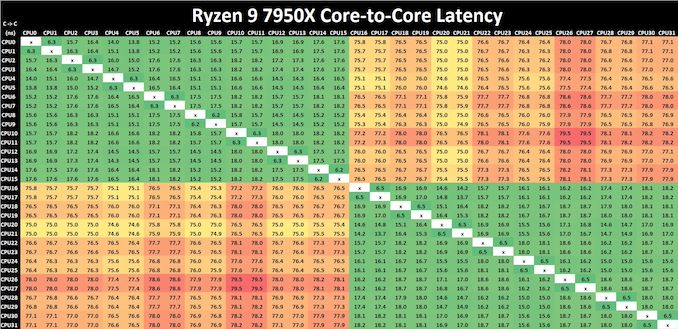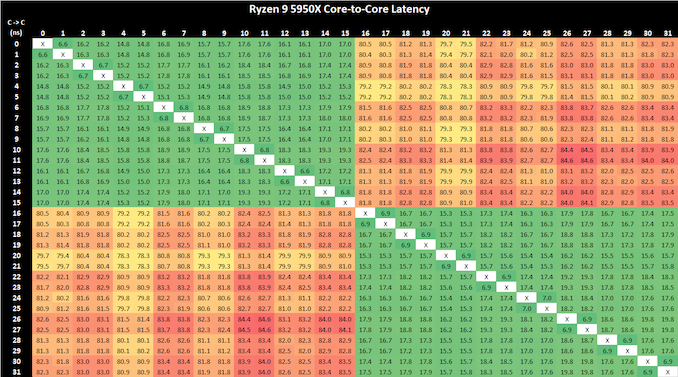AMD Zen 4 Ryzen 9 7950X and Ryzen 5 7600X Review: Retaking The High-End
by Ryan Smith & Gavin Bonshor on September 26, 2022 9:00 AM ESTCore-to-Core Latency
As the core count of modern CPUs is growing, we are reaching a time when the time to access each core from a different core is no longer a constant. Even before the advent of heterogeneous SoC designs, processors built on large rings or meshes can have different latencies to access the nearest core compared to the furthest core. This rings true especially in multi-socket server environments.
But modern CPUs, even desktop and consumer CPUs, can have variable access latency to get to another core. For example, in the first generation Threadripper CPUs, we had four chips on the package, each with 8 threads, and each with a different core-to-core latency depending on if it was on-die or off-die. This gets more complex with products like Lakefield, which has two different communication buses depending on which core is talking to which.
If you are a regular reader of AnandTech’s CPU reviews, you will recognize our Core-to-Core latency test. It’s a great way to show exactly how groups of cores are laid out on the silicon. This is a custom in-house test, and we know there are competing tests out there, but we feel ours is the most accurate to how quick an access between two cores can happen.

Click to enlarge (lots of cores and threads = lots of core pairings)
Comparing core to core latencies from Zen 4 (7950X) and Zen 3 (5950X), both are using a two CCX 8-core chiplet design, which is a marked improvement over the four CCX 16-core design featured on the Zen 2 microarchitecture, the Ryzen 9 3950X. The inter-core latencies within the L3 cache range from between 15 ns and 19 ns. The inter-core latencies between different cores within different parts of the CCD show a larger latency penalty of up to 79.5 ns, which is something AMD should work on going forward, but it's an overall improvement in cross CCX latencies compared to Zen 3. Any gain is still a gain.
Even though AMD has opted for a newer and more 'efficient' IOD which is based on TSMC's 6 nm node. It is around the same size physically as the previous AMD IOD on Zen 3 manufactured on GlobalFoundries 12 nm node, but with a much larger transistor count. Within the IOD is the newly integrated RDNA 2 graphics, although this isn't typical iGPU in the sense that an APU is. A lot of the room on the IOD is made up of the DDR5 memory controller or IMC, as well as the chips PCIe 5.0 lanes, and of course, connects to the logic through its primary interconnect named Infinity Fabric. All of these variables play a part on power, latency, and operation.

AMD Ryzen 9 5950X Core-to-Core Latency results
It's actually astounding how similar the latency performance of the Ryzen 9 7950X (Zen 4) is when compared directly to the Ryzen 9 5950X (Zen 3), despite being on the new 5 nm TSMC manufacturing process. Even with a change of IOD, but with the same interconnect, the inter-core latencies within the Ryzen 9 7950X are great in terms of cores within the same core complex; latency does degrade when pairing up with a core in another chiplet, but this works and AMD's Ryzen 5000 series proved that the overall penalty performance is negatable.










205 Comments
View All Comments
Freeb!rd - Monday, September 26, 2022 - link
This paragraph reads like someone having a stroke while writing it..."Although this is overridable through manually overclocking with a maximum TJ Max of up to 115°C, it’s key tovitalte that users will need to use more premium and aggressive cooling types to squeeze every last drop of performance from ZAMD intended thistended when designing Zen 4, and as such, has opted not to bundls own CPU coolers with the retail packages."
and someone's spell checker is broken. Reply
gryer7421 - Monday, September 26, 2022 - link
It reads like a GTP-3 BOT .... :( ReplyThreska - Monday, September 26, 2022 - link
We now know "Zencally " is a word. ReplyGavin Bonshor - Monday, September 26, 2022 - link
Hi, yeah something screwy happened, but it's fixed now. Apologies. I think it may be time to update to a new system, and software. This isn't the first time it's jumbled stuff up for me. ReplyCow86 - Monday, September 26, 2022 - link
I wish I could say that all the errors in the article are fixed, but that very paragraph even still has several (big) errors in it... A missing letter is one thing, half a sentence just missing and going into the next is another. Replyherozeros - Monday, September 26, 2022 - link
Keep the copy editor awake, or fire them. Grammar/syntax/CMS error, it doesn't matter if it gives me a headache reading this. ReplyRyan Smith - Monday, September 26, 2022 - link
Unfortunately we're having to do this kind of live. It's been a very busy past two weeks and we haven't had as much time to prepare as we like. So most of what you're seeing is first-draft copy, which I'll get around to editing as I can.Digital publications do not employ dedicated copy editors any more. They have all been let go for cost efficiency reasons. Reply
flyingpants265 - Monday, September 26, 2022 - link
What? Come on now. ReplyHifihedgehog - Monday, September 26, 2022 - link
@flypants265: It's kind of like Microsoft who got rid of their QA team and made all of their developers honorary QA tests. They can't help it that their leadership is being stupid. Don't blame Ryan or Gavin. Blame these greedy cheapskates that likewise didn't want to pay Ian Cutress enough to want to stay. ReplyHifihedgehog - Monday, September 26, 2022 - link
*QA testers Reply